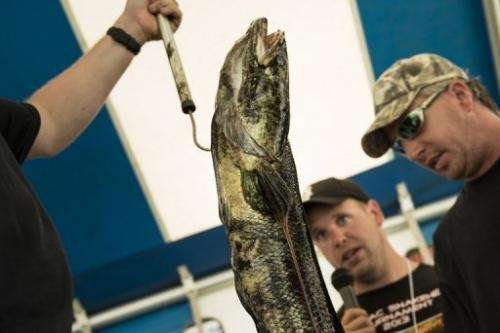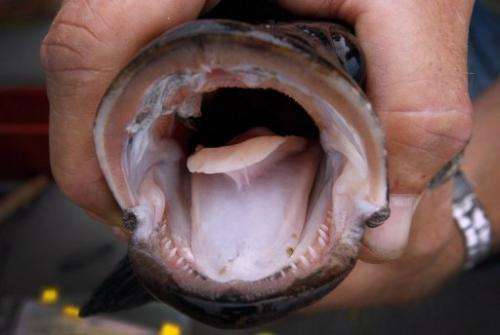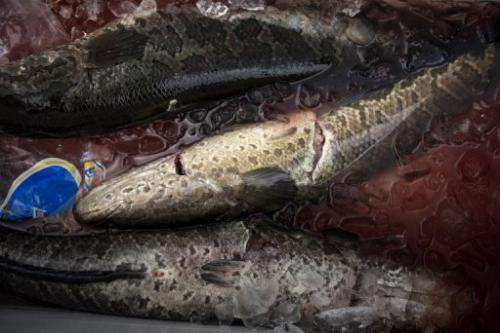In US, struggle against snakehead ends on plates

The snakehead is an invasive species of fish from Asia that is threatening the delicate ecosystem of the Potomac River that flows through Washington into the Atlantic Ocean.
It also tastes great with onions and butter, said sport fisherman Brett Miron after catching a total of 110 pounds (50 kilograms) of the otherwise slimy, hard-to-catch fish at the recent Potomac Snakehead Tournament.
The yearly contest in Maryland's Smallwood State Park brings together anglers and bow fishermen—those who catch fish with a bow and arrow—from many miles around in hopes of bringing snakehead numbers down.
"It brings people together to have fun and to do something for the environment. It's a winning formula," said Austin Murphy, organizer of the tournament that this year reaped 165 fish weighing a combined total of 1,058 pounds.
Growing up to three feet (one meter) in length, the sharp-toothed snakehead first appeared in the Potomac and its tributaries about a decade ago, arousing concern about its impact on local biodiversity.
Local authorities, adventurous restaurateurs and environmental activists responded by banding together to promote the snakehead's weakness: it tastes good.
"When we first started (the tournament three years ago), people would throw away their snakeheads," Murphy said.
"Now people are very tight with their snakeheads. They want to take them and enjoy them at home. It's nice to see that transformation."
Like the 150-odd other fisherman who registered for this year's tournament at the end of June, Miron—part of a five-man bowfishing team—brought along an icebox to conserve his catch.

The 46-year-old mechanic from rural Maryland was motivated by the $1,500 grand prize as well as the gastronomical feast that is no small part of the tournament.
"It tastes very good. I like them deep fried or grilled with onions and butter," Miron told AFP, although he cautioned that snakehead is not the easiest fish to catch.
"It's a very clever fish, very smart. It's been in these waters for a few years. They're learning to know when to leave when they see the boats coming. They are a hard fish to catch," he said.
Chad Wells likes his snakefish barbecued. For three years, the thirtysomething chef has featured it at his restaurant in Maryland's capital Annapolis, serving it with mango and peppers or spiced tacos.
"It's a really good fish, really versatile. Every time you eat it, you're doing a service to the ecosystem," said Wells as he grilled a few firm white filets that he will soak with a barbecue sauce.
Highly appreciated in Asia, the snakehead's presence is thought to be the result of some runaways from a live fish market in New York's Chinatown neighborhood.
"They're fairly common in the live fish market. They are a delicacy. You could go to a market, buy a live fish, bring it home and cook it," said Joshua Newhard, a biologist with the US Fish and Wildlife Service.
Snakeheads are also common in the aquarium trade, he said, but they may grow so big that their keepers, rather than kill them, prefer to set them loose into the open water.

Their resilience does the rest.
Snakeheads spawn at least twice a year, they live 10 to 15 years, can survive a day or two out of the water in a humid place—and eat practically anything, including native fish species.
"They eat young white perch, yellow perch... occasionally young large-mouth bass. They are capable of eating a wide variety of prey," said Joseph Love of the Maryland state department of natural resources.
"Our concern is that they will have a local negative impact on the relative abundance of other species," said Love, who estimates the number of Potomac snakefish to be in the thousands, even tens of thousands.
Tasting snakehead for the first time, Luke Frazza of the Washington suburb of Fairfax, Virginia, was impressed.
"It was delicious," he said. "Very flaky, and it did not have any kind of unusual taste. I had it fried and broiled; I preferred the grilled. I would order it in an restaurant."
© 2013 AFP


















